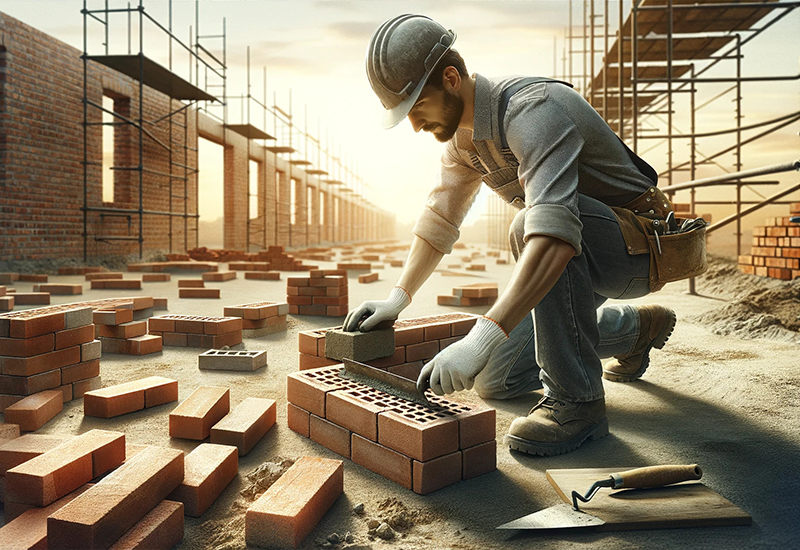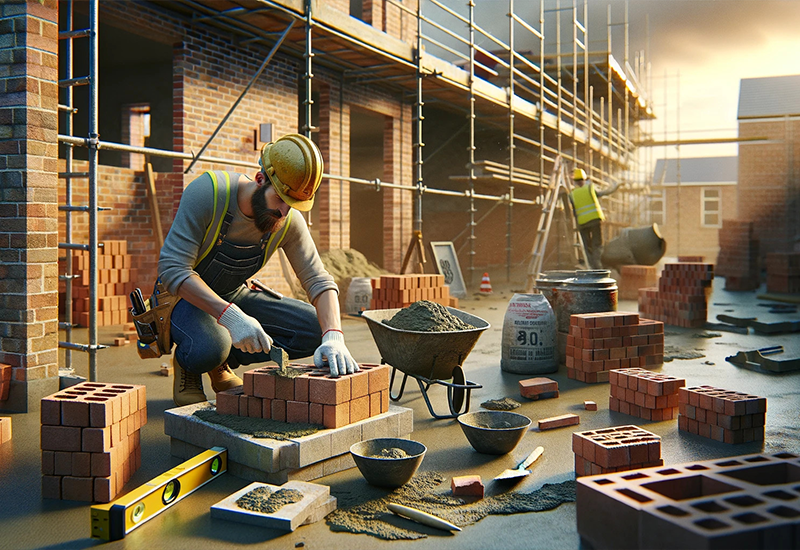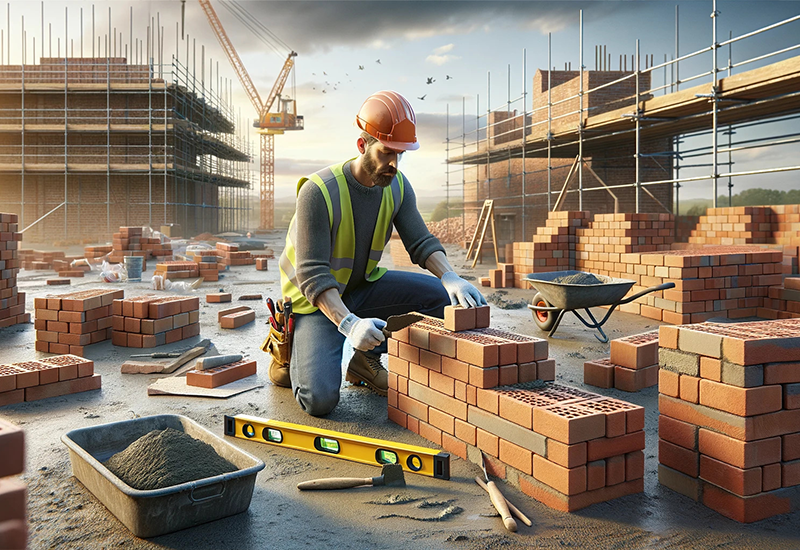
What is a brickmason? This question opens a gateway into an essential and skilled trade, integral to the construction industry. Brickmasons are the craftsmen who skillfully lay bricks, shaping the very foundations and aesthetics of our buildings. They blend strength, precision, and creativity, playing a pivotal role in constructing durable and visually appealing structures. Their expertise extends from residential homes to grand commercial edifices, making them indispensable in the building world.
Table of Contents
What is a Brickmason?
A brickmason, often simply known as a bricklayer, is a professional skilled in constructing and repairing structures made of bricks, blocks, and other similar materials. Their craft is fundamental in the construction industry, contributing significantly to building various structures including houses, commercial buildings, and historical monuments.
A brickmason’s work involves more than just laying bricks. They are experts in reading and interpreting construction drawings, ensuring each structure meets both aesthetic and functional requirements. Their role often requires them to work closely with architects and engineers, contributing insights from their expertise to enhance building designs.
Their skills extend to selecting appropriate materials, ensuring quality, and adhering to safety standards. Adept in different laying patterns, brickmasons can create visually appealing and structurally sound designs. They are the artisans who transform raw materials into durable, functional, and often beautiful structures.
What does a Brickmason do?

The daily responsibilities of a brickmason are diverse and involve several detailed tasks. Here’s a closer look:
- Reading and Interpreting Blueprints: Before starting any project, brickmasons study blueprints and building plans to understand the design and structural requirements. This includes analyzing dimensions, checking alignment, and preparing the layout of the brickwork.
- Estimating Material Requirements: Accurately calculating the amount of bricks, mortar, and other materials needed is crucial. They consider factors like the size of the area, type of bricks, and the pattern of bricklaying to determine the required quantities.
- Preparing the Worksite: Setting up the area where bricklaying will occur involves clearing any debris, setting up scaffolding, and ensuring all safety measures are in place.
- Mixing Mortar: An essential skill of a brickmason is mixing mortar – a blend of cement, sand, and water. They achieve the right consistency and strength suitable for the specific type of brickwork.
- Laying Bricks and Blocks: The core of their job, brickmasons lay bricks in the determined pattern, applying mortar between each layer, ensuring the structure is level, aligned, and set according to the plan.
- Cutting and Trimming Bricks: Using tools like chisels, hammers, and power saws, they cut and trim bricks to fit corners, edges, and specific designs. This requires precision and a steady hand.
- Ensuring Structural Integrity: They check the strength and stability of the construction, making necessary adjustments to ensure the structure is sound and safe.
- Repair and Maintenance Work: Apart from new constructions, brickmasons also repair existing brick structures, replacing damaged bricks and fixing mortar joints.
- Collaboration and Communication: Effective communication with other construction professionals is vital. Brickmasons often work in teams and coordinate with architects, engineers, and other tradespeople to ensure the project progresses smoothly.
- Adhering to Safety Protocols: Safety is paramount in brickmasonry. They follow strict safety guidelines, use personal protective equipment, and maintain a safe and organized worksite to prevent accidents.
Types of Brickmasons
Brickmasonry, a field diverse in its applications, branches into several specializations. Here’s an overview, presented in both a descriptive and tabular format, for clarity:
- Residential Brickmason: These professionals focus on homes and housing projects. They craft walls, fireplaces, patios, and other structures commonly found in residential properties. Skill in intricate designs and a keen eye for detail are essential.
- Commercial Brickmason: Working on larger scale projects like office buildings and shopping malls, commercial brickmasons handle more extensive and complex construction jobs. They often work with a variety of materials and need to be adept at coordinating with other construction teams.
- Restoration Brickmason: Specializing in the repair and preservation of historic and aged brick structures, restoration brickmasons merge traditional techniques with modern practices to maintain and restore historical integrity.
- Industrial Brickmason: Focused on industrial settings such as factories and plants, these masons are skilled in handling heavy-duty materials and often work under challenging conditions, dealing with high-temperature environments and larger-scale constructions.
- Specialized Brickmason: This category includes those with expertise in unique areas like refractory brickmasonry for kilns and furnaces, or artistic bricklaying for decorative designs.
Table: Types of Brickmasons
| Type | Focus Area | Key Skills |
| Residential Brickmason | Homes, Residential Buildings | Detail-oriented, Design Skills |
| Commercial Brickmason | Office Buildings, Shopping Malls | Large-scale Construction |
| Restoration Brickmason | Historic Structures | Preservation Techniques |
| Industrial Brickmason | Factories, Industrial Sites | Heavy-duty Material Handling |
| Specialized Brickmason | Unique Applications | Niche Skills, Artistry |
What is the Workplace of a Brickmason Like?

The workplace of a brickmason is as varied as the projects they undertake. It can range from quiet residential neighborhoods to bustling commercial construction sites.
- Outdoor and Indoor Environments: Brickmasons work both outdoors and indoors. Outdoor projects may be subject to weather conditions, requiring masons to adapt to different climates and temperatures. Indoor projects, such as those in industrial settings, can involve working in confined spaces or around other ongoing construction activities.
- Residential Areas: In residential projects, brickmasons often work in more controlled and smaller-scale environments, focusing on detail and aesthetic appeal. Their role here is not just functional but also contributes significantly to the home’s overall look and feel.
- Commercial and Industrial Sites: On commercial or industrial projects, the environment is more dynamic. These sites are larger, often involving coordination with a range of other professionals. Here, brickmasons face more complex challenges, from adhering to strict timelines to ensuring their work aligns perfectly with other elements of the construction.
- Restoration Sites: Working on restoration projects, brickmasons might find themselves in historical settings where preserving the original architecture is as important as the structural integrity of their work. These environments demand a respectful understanding of historical construction techniques.
- Physical Nature of Work: Across all these settings, the work of a brickmason is physically demanding. It involves lifting, bending, and working with heavy materials, making physical fitness and stamina essential.
- Safety Considerations: Regardless of location, safety remains a priority. Brickmasons are equipped with safety gear and adhere to protocols to minimize risk, especially when working at heights or with heavy machinery.
Education and Training
Becoming a brickmason typically involves a blend of formal education and hands-on training. It’s a journey where learning the ropes happens both in the classroom and on the job.
- High School Education: Starting with high school, courses in mathematics, mechanical drawing, and industrial arts lay a solid foundation for understanding the basics of construction.
- Vocational Training: Many brickmasons begin their journey with vocational training. These programs, often offered at community colleges and trade schools, cover topics like blueprint reading, mathematics, building code requirements, and safety practices.
- Apprenticeships: Perhaps the most critical part of a brickmason’s education is the apprenticeship. Lasting typically 3-4 years, these programs combine on-the-job training with classroom instruction. Apprentices get the chance to work under experienced masons, learning the craft firsthand.
- Certifications: Certifications can enhance a brickmason’s credentials. Organizations like the Mason Contractors Association of America offer various certification programs that validate a mason’s skills and knowledge.
- Continuing Education: The learning doesn’t stop after formal training. Ongoing education is important to stay up-to-date with new techniques, materials, and regulations in the construction industry.
The Artistic Aspect of Bricklaying
Bricklaying isn’t just about constructing sturdy walls; it’s also an art form. In this craft, precision meets creativity, resulting in structures that are both functional and beautiful.
- Design and Pattern Creation: Brickmasons often work with intricate designs and patterns, turning simple bricks into stunning visual elements. Patterns like herringbone, basket weave, or the classic running bond are not only visually appealing but also add structural integrity.
- Aesthetic and Functional Balance: The true skill lies in balancing aesthetics with functionality. A well-laid brick wall is durable and weather-resistant, while also enhancing the visual appeal of the structure.
- Custom Works: For custom projects, brickmasons can become true artists, crafting unique designs and features like curved walls, arches, or ornamental brickwork that reflect the client’s vision and the mason’s creativity.
Health, Safety, and Physical Requirements
In brickmasonry, safety and physical well-being are paramount. The work is physically demanding and carries certain risks, making it crucial to follow safety standards.
- Physical Stamina and Strength: Brickmasons need to be physically fit. They often lift heavy materials and spend long hours standing, bending, and kneeling.
- Safety Gear and Protocols: Wearing the right safety gear – like hard hats, gloves, and steel-toed boots – is a must. Brickmasons also follow safety protocols to prevent accidents, especially when working at heights or with machinery.
- Regular Training: Safety training sessions are a regular part of a brickmason’s life, ensuring they are up to date with the best practices to maintain a safe working environment.
The Future of Brickmasonry
Brickmasonry, like many trades, is evolving. The future holds exciting prospects shaped by technology and changing construction trends.
- Technological Advancements: From digital planning tools to advanced bricklaying machines, technology is transforming how brickmasons work. These advancements can lead to greater precision and efficiency.
- Sustainable Practices: With a growing focus on sustainability, the use of eco-friendly materials and techniques is on the rise in brickmasonry.
- Diverse Opportunities: As construction techniques evolve, brickmasons who adapt and learn new skills will find a range of opportunities in both traditional and innovative construction projects.
Conclusion:
In conclusion, understanding what a brickmason is reveals a world where technical skill meets creativity. Brickmasons are vital in shaping our physical surroundings, contributing to both the functionality and beauty of our infrastructure. Their role demands not only physical strength and precision but also an artistic eye, making brickmasonry a unique and rewarding profession. As we have explored, the trade of a brickmason is about more than just laying bricks; it’s about building the very essence of our architectural heritage.
FAQs:
Q: What Training is Required to Become a Brickmason?
A: Becoming a brickmason typically involves a mix of formal education and hands-on apprenticeship. Candidates often start with technical courses in high school or vocational schools, followed by apprenticeships to gain practical, on-the-job experience.
Q: What Skills are Essential for a Brickmason?
A: Key skills for a brickmason include precision in laying bricks, ability to read and interpret blueprints, physical stamina, and an eye for detail. Additionally, understanding of various brick patterns and safety protocols is crucial.
Q: Can Brickmasons Specialize in Certain Types of Projects?
A: Yes, brickmasons can specialize in areas such as residential, commercial, or restoration projects. Each specialization requires a unique set of skills and knowledge tailored to different construction environments.
Q: What’s the Job Outlook for Brickmasons?
A: The demand for brickmasons remains steady, as their skills are essential in both new construction and the repair and restoration of existing structures. Ongoing development in urban and residential areas fuels the need for skilled brickmasons.
Q: Are There Technological Advancements Impacting Brickmasons?
A: Yes, technological advancements like digital planning tools and bricklaying machines are shaping the future of brickmasonry. These tools enhance precision and efficiency, though the skilled hands of a brickmason remain irreplaceable.


